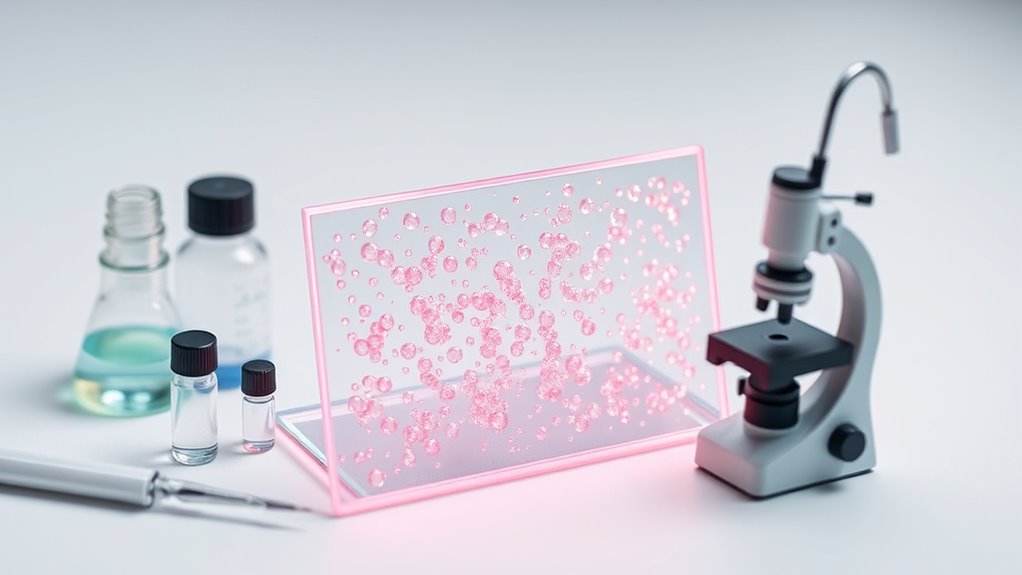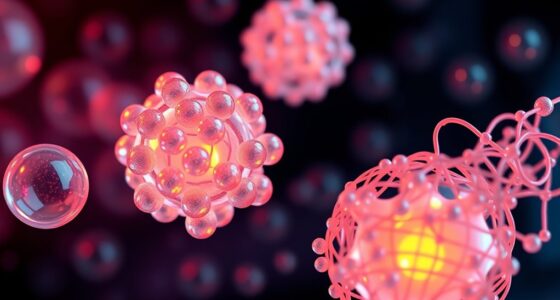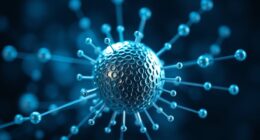Nanomedicine involves tiny materials that can interact uniquely with biological systems, raising safety concerns. To assess risks, scientists use in vitro tests, animal studies, and computer models, but challenges like unpredictable interactions and lack of standard protocols remain. Regulations are evolving to better address these issues, with future efforts focusing on advanced testing methods and collaborative approaches. Exploring this further can help you understand how safety is managed in cutting-edge nanomedical treatments.
Key Takeaways
- Nanomedicine safety assessment requires understanding nanoparticle interactions with biological systems, including cellular uptake and immune responses.
- Traditional toxicity tests may not capture nanomaterial-specific effects like increased reactivity and tissue accumulation.
- Standardized protocols and advanced models, such as organ-on-a-chip, are being developed for more accurate nanotoxicity evaluation.
- Regulatory frameworks are evolving to include nanomaterial-specific safety guidelines and international harmonization efforts.
- Interdisciplinary collaboration and transparent data sharing are essential for balancing innovation with safe nanomedical applications.
Understanding Nanomaterials and Their Biological Interactions
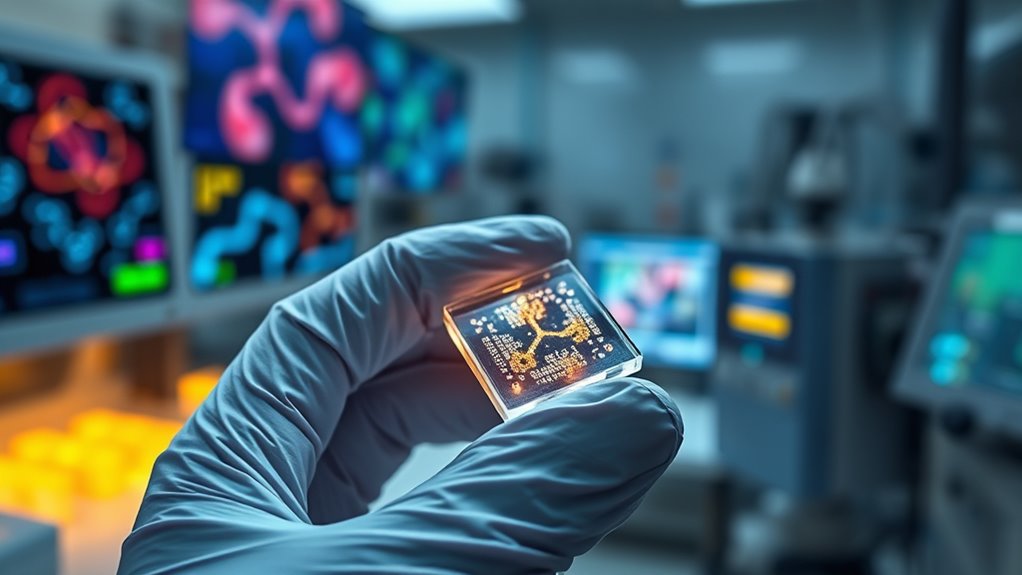
Nanomaterials are engineered particles with dimensions typically less than 100 nanometers, which give them unique physical and chemical properties. These small sizes result in a high surface area to volume ratio, making them highly reactive and capable of crossing biological barriers more easily than larger particles. When you introduce nanomaterials into biological systems, they can interact with cells, proteins, and other biomolecules in complex ways. These interactions may lead to cellular uptake, influence immune responses, or cause oxidative stress. Understanding how nanomaterials behave in biological environments is vital for predicting their safety and potential toxic effects. Their small size and reactivity mean you need to carefully consider how they might accumulate or interact within tissues and fluids.
Current Methods for Assessing Nanotoxicity

Evaluating nanotoxicity requires a combination of in vitro, in vivo, and computational methods to accurately assess the safety of nanomaterials. You’ll typically start with laboratory-based tests, such as cell viability assays and oxidative stress measurements. Animal studies then help observe biological responses in complex systems. Computational models, like QSAR (Quantitative Structure-Activity Relationship), predict potential toxic effects based on nanomaterial properties. Additionally, understanding the specific Kia Tuning modifications can inform safety assessments by revealing how material changes influence biological interactions.
Assessing nanotoxicity involves in vitro, in vivo, and computational methods for comprehensive safety evaluation.
Key methods include:
- Cell-based assays for cytotoxicity and inflammation
- Animal models for systemic toxicity and biodistribution
- High-throughput screening for rapid testing of multiple samples
- In silico modeling to forecast long-term impacts
These combined approaches provide an all-encompassing understanding of nanomaterial safety, guiding responsible development.
Challenges in Evaluating Safety at the Nanoscale

Evaluating safety at the nanoscale presents unique challenges because the tiny size and high surface area of nanomaterials lead to unpredictable interactions with biological systems. You must account for how these particles behave differently than bulk materials, which complicates toxicity assessments. Traditional testing methods often fall short because they don’t capture nanoscale-specific effects, such as increased reactivity or cellular uptake. You also face difficulties in characterizing nanomaterials consistently, as slight variations in size, shape, or surface chemistry can substantially alter interactions. Furthermore, the lack of standardized tests and clear protocols adds to the complexity. You need advanced tools and multidisciplinary approaches to accurately evaluate risks, but the rapid pace of nanotech development often outstrips regulatory and scientific frameworks. Considering the importance of high surface area in influencing nanomaterial behavior is crucial for developing effective safety assessments.
Regulatory Frameworks and Guidelines for Nanomedicine
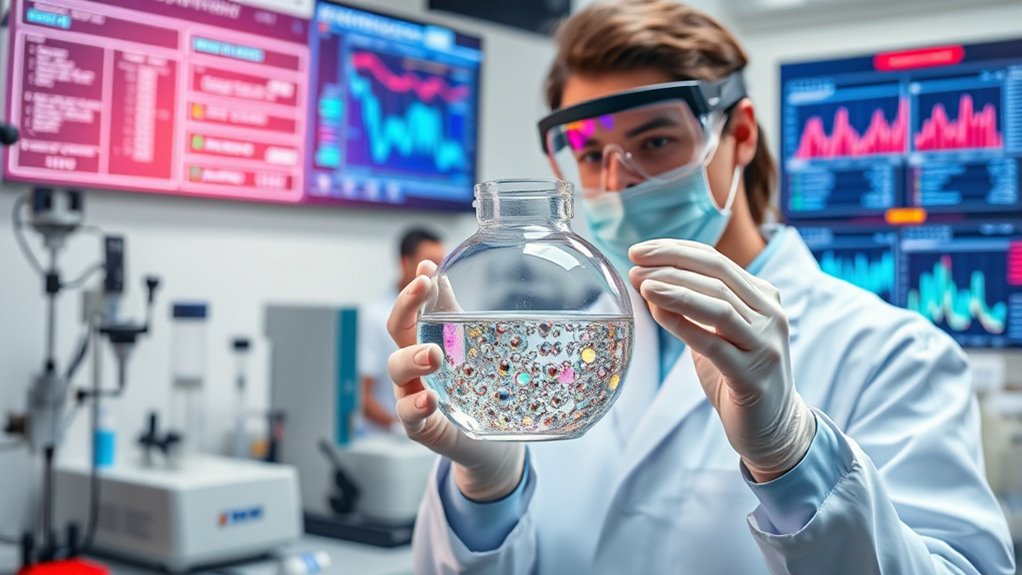
How do regulatory frameworks keep pace with the rapid advancements in nanomedicine? They’re evolving to address unique challenges posed by nanomaterials. You’ll find guidelines are often based on existing drug and device regulations, but tailored for nanoscale properties. Regulatory agencies are working to develop standardized testing protocols that assess safety, efficacy, and environmental impact. They also encourage collaboration among stakeholders to update policies swiftly. Key aspects include: safety considerations — incorporating nanomaterial-specific risk assessment methods, creating adaptable registration processes for innovative products, promoting transparency through extensive reporting, and facilitating international harmonization of standards.
Future Directions in Ensuring Safe Nanomedical Applications
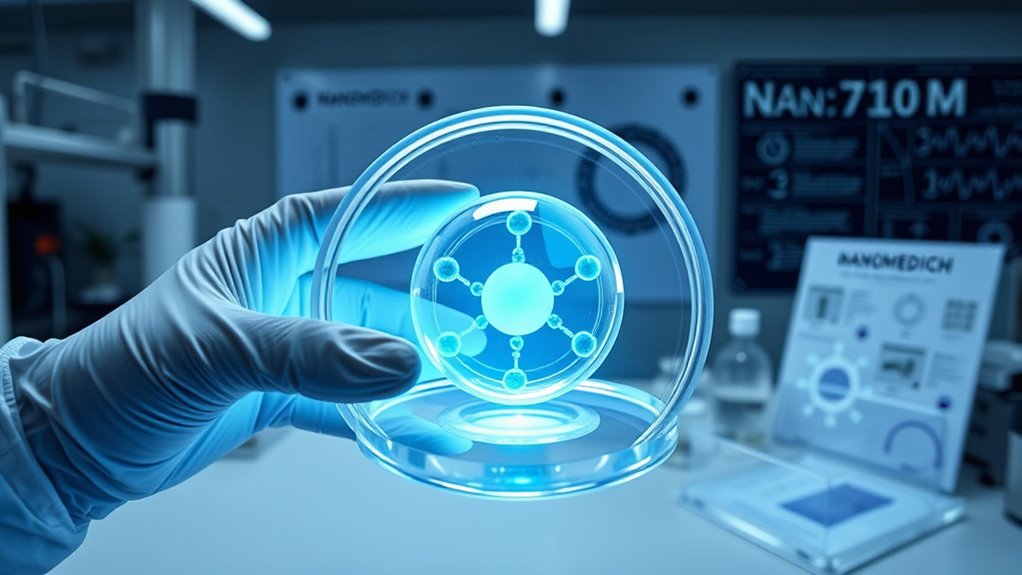
As nanomedicine continues to advance rapidly, ensuring its safety requires innovative approaches and proactive strategies. You should focus on developing standardized testing protocols to better predict nanomaterials’ biological impacts. Embracing advanced in vitro models, such as organ-on-a-chip systems, can provide more relevant safety data while reducing animal testing. Incorporating real-time monitoring tools allows for early detection of adverse effects during clinical trials. Additionally, fostering interdisciplinary collaboration among toxicologists, engineers, and regulators will help create exhaustive safety frameworks. You must also prioritize transparency and data sharing to build public trust. As technology evolves, staying ahead with adaptive regulations and continuous risk assessment will be essential to safeguard health without hindering innovation. Hydration is also crucial, as proper water intake supports overall cellular and biological functions during nanomedical treatments.
Frequently Asked Questions
How Do Nanomaterials Cross Biological Barriers Like the Blood-Brain Barrier?
You can imagine nanomaterials crossing biological barriers like the blood-brain barrier by exploiting their tiny size and surface properties. They often use mechanisms like transcytosis or can be engineered to target specific receptors on barrier cells. By doing so, they effectively slip through tight junctions or get actively transported, enabling them to deliver drugs directly into the brain. This targeted approach improves treatment efficacy while minimizing side effects.
What Are the Long-Term Environmental Impacts of Nanomedicine Disposal?
Sure, because dumping nanomedicine waste into the environment sounds like a brilliant idea, right? In reality, you risk contaminating water sources, harming wildlife, and creating resistant microbes. These tiny particles can accumulate, persist, and enter food chains, causing unpredictable ecological chaos. So, next time you think about disposal, remember: what goes in the trash might just come back to haunt you in ways you never imagined.
How Do Individual Genetic Differences Affect Nanomedicine Toxicity?
Your genetic differences influence how your body processes nanomedicine, affecting toxicity levels. Variations in enzymes and immune responses can cause some individuals to metabolize or clear nanoparticles more slowly, increasing potential adverse effects. Conversely, others might break down nanomedicine quickly, reducing efficacy or safety. Understanding your genetic makeup helps predict these responses, guiding personalized treatments and minimizing risks associated with nanomedicine toxicity.
Are There Standardized Protocols for Manufacturing Safe Nanomaterials?
While there’s no single standard for all nanomaterials, you’ll find emerging guidelines aimed at guaranteeing safety. You should follow best practices like thorough characterization, biocompatibility testing, and risk assessments, which many organizations are developing into more formal protocols. By adhering to these evolving standards, you can better ensure your nanomaterials are produced responsibly, minimizing potential risks and fostering trust in their safe application.
How Can Patient-Specific Factors Influence Nanomedicine Safety Assessments?
You should consider patient-specific factors like age, genetics, health status, and immune response when evaluating nanomedicine safety. These variables influence how your body absorbs, distributes, metabolizes, and eliminates nanomaterials. By tailoring safety evaluations to your individual characteristics, healthcare providers can better predict potential adverse reactions and optimize treatment efficacy. Personalized assessments help ensure that nanomedicine therapies are both safe and effective for each unique patient.
Conclusion
As you navigate the world of nanomedicine, remember that “prevention is better than cure.” While advancements hold promise, understanding nanomaterials’ interactions and safety challenges is vital. By staying informed of current assessment methods and evolving regulations, you can help guarantee these innovations benefit health without unintended risks. Embrace a cautious yet optimistic outlook, because in the domain of nanotechnology, safety truly paves the way for groundbreaking medical breakthroughs.
